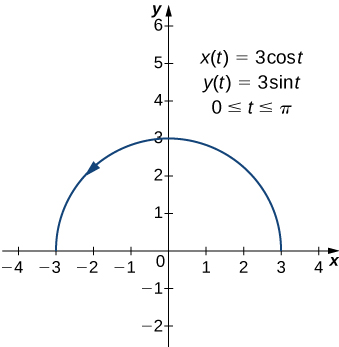| << Chapter < Page | Chapter >> Page > |
We can summarize this method in the following theorem.
Consider the plane curve defined by the parametric equations
and assume that and are differentiable functions of t. Then the arc length of this curve is given by
At this point a side derivation leads to a previous formula for arc length. In particular, suppose the parameter can be eliminated, leading to a function Then and the Chain Rule gives Substituting this into [link] gives
Here we have assumed that which is a reasonable assumption. The Chain Rule gives and letting and we obtain the formula
which is the formula for arc length obtained in the Introduction to the Applications of Integration .
Find the arc length of the semicircle defined by the equations
The values to trace out the red curve in [link] . To determine its length, use [link] :
Note that the formula for the arc length of a semicircle is and the radius of this circle is 3. This is a great example of using calculus to derive a known formula of a geometric quantity.

We now return to the problem posed at the beginning of the section about a baseball leaving a pitcher’s hand. Ignoring the effect of air resistance (unless it is a curve ball!), the ball travels a parabolic path. Assuming the pitcher’s hand is at the origin and the ball travels left to right in the direction of the positive x -axis, the parametric equations for this curve can be written as
where t represents time. We first calculate the distance the ball travels as a function of time. This distance is represented by the arc length. We can modify the arc length formula slightly. First rewrite the functions and using v as an independent variable, so as to eliminate any confusion with the parameter t :
Then we write the arc length formula as follows:
The variable v acts as a dummy variable that disappears after integration, leaving the arc length as a function of time t. To integrate this expression we can use a formula from Appendix A ,
We set and This gives so Therefore
and
This function represents the distance traveled by the ball as a function of time. To calculate the speed, take the derivative of this function with respect to t. While this may seem like a daunting task, it is possible to obtain the answer directly from the Fundamental Theorem of Calculus:

Notification Switch
Would you like to follow the 'Calculus volume 2' conversation and receive update notifications?